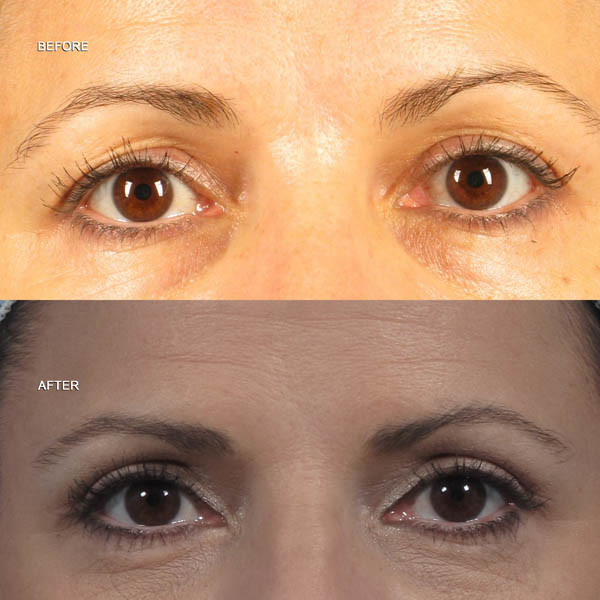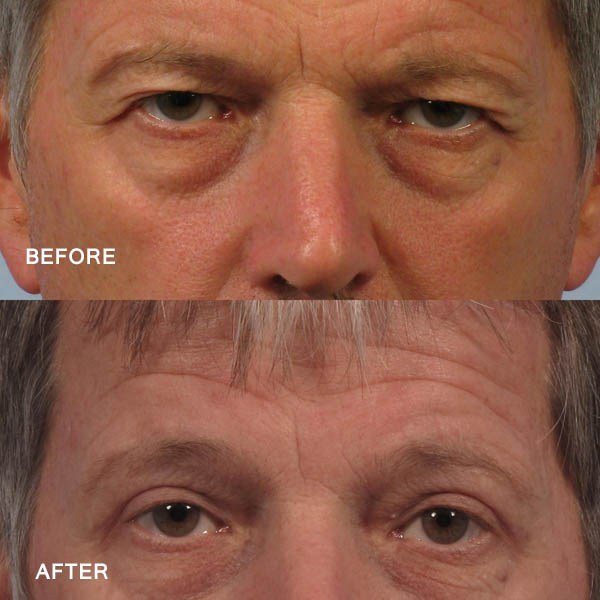What does it treat?
Loose or sagging upper eyelid skin (upper lid dermatochalasis), excess fat pouches (upper steatoblepharon), or other aging signs of the upper eyelid.
How it’s done
Incision planning
A marking pen is used to mark the upper eyelid crease. The amount of excess eyelid skin above the crease is determined. There is a transition from the thin skin of the eyelid to the thick skin of the eyebrow that usually demarcates the area of looseness. Enough skin must be left behind to allow for normal eyelid closure (usually at least 20-22 millimeters of skin is left from the eyelash line to the brow hairs).
The design of the skin marked for removal depends on the structure of the patient and the surgeon’s goals and is customized accordingly. The shape is generally a curved ellipse. The outer edge of the markings may extend past the outer corner of the eyelid if there is significant hooding of skin in this area.
Local anesthetic
The area is anesthetized with local anesthetic, injected with a small needle.
Skin removal
The excess skin is removed with an incision, using one of many surgical tools. These may include a laser, radiofrequency device, electrosurgical device, scalpel, scissors, or a combination of instruments.
Laser can also be used to resurface the remaining upper eyelid skin in order to reduce wrinkles and sun damage.
Removal of muscle
The muscle under the skin of the eyelid (orbicularis oculus muscle) may be partially removed or may be left untouched. Similarly, the eyelid fat beneath this muscle may be sculpted or left untouched, based on the desired goals and the patient’s specific anatomy.
Removal of upper eyelid fat
There are 2 main fat compartments in the upper eyelid, one at the inner corner of the lid and one in the center of the lid (bulges at the outer part of the upper eyelid are usually caused by the lacrimal gland). If fat is removed it is usually done at the inner corner of the upper eyelid, if there is a bulge present. Fat removal from the center part of the upper eyelid has the potential to create a hollow space or a sulcus, which can lead to a more aged appearance. Sometimes central fat removal is still desired, particularly when aiming to produce a more visible eyelid shelf. Whenever possible, eyelid muscle and fat are left undisturbed, so that the native eyelid structure, function and volume are best preserved. Upper eyelid fat may also be re-positioned to add volume to a more hollow area of the eyelid.
Crease fixation and skin closure
The eyelid crease may be fixated with buried stitches, if necessary. Then stitches are used to close the eyelid skin. Different stitch materials can be used, including nylon, polypropylene, or dissolvable stitches. The incision is generally placed in the same location as the natural eyelid crease to disguise signs of surgery.
Follow-up care
Stitches are usually removed at 5-10 days. Swelling and/or bruising is common during this time. Antibiotic ointment may be prescribed to apply to the incision area. It may take several months for healing to be complete, and during this time the scar generally fades and becomes less noticeable.
Potential risks
Rare complications include bleeding, infection, thickened scars, difficulty with eyelid closure and visual disturbances. More common complications can include temporary eye dryness, suture cysts (small bumps along the incision line), residual excess upper eyelid skin, prolonged swelling or redness, and asymmetry.
Alternatives to upper eyelid lift
Botulinum toxin injections can cause eyebrow elevation which in turn may eliminate some eyelid skin hooding. Browplasty can also indirectly eliminate some upper eyelid skin excess in a similar manner.
Related procedures
It is common to perform other eyelid procedures at the same time as upper blepharoplasty. These may include treatment of a fallen tear gland (lacrimal gland) at the outer edge of the upper eyelid, treatment of a low-riding eyelid (blepharoptosis or ptosis repair), a lower eyelid lift (lower blepharoplasty), brow lift (browplasty), laser skin resurfacing, botulinum toxin, and dermal fillers.


